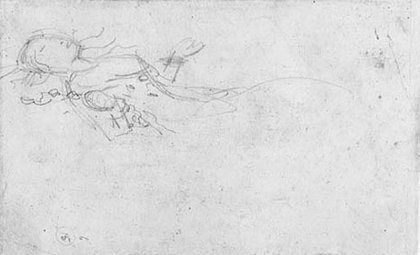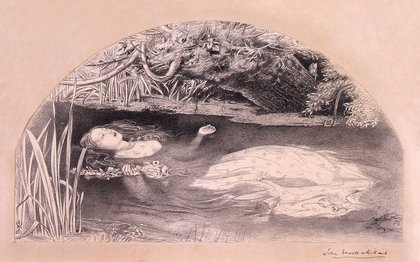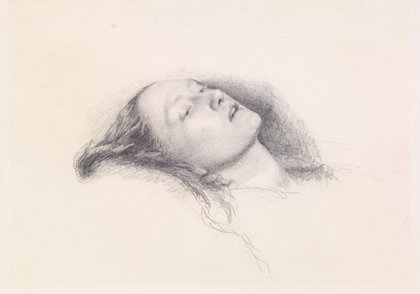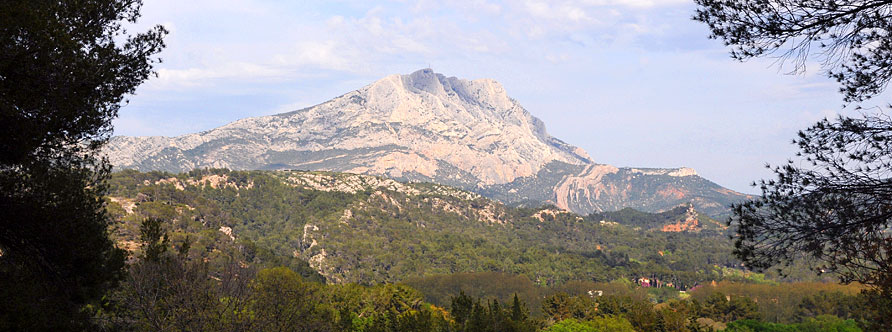Romantic Era : My Style Preference
I prefer the Pre-Raphaelite style of art from this era as opposed to the Post-Impressionism style . The Pre-Raphaelites wanted to step outside the normal depictions and interpretations of art. They wanted to “revive British art; to make it as dynamic, powerful and creative as the late medieval and early Renaissance works created before the time of the Italian artist Raphael; and to find ways of expressing both nature and true emotions in art” (TheArtStory). While post impressionists “extended Impressionism while rejecting its limitations”. Post-Impressionism is characterized by a “subjective approach to painting, as artists opted to evoke emotion rather than realism in their work”. The Pre-Raphaelite style can be “characterized by minute description of detail, a luminous palette of bright colors that recalls the tempera paint used by medieval artists, and subject matter of a noble, religious, or moralizing nature” (Meagher). Most of their feminie subject matter came from “women whose beauty is based on real-life mistresses and models of the English painter Dante Gabriel Rossetti” (Unknown). Furthermore, some of the most prominent muses for Pre-Raphaelite Elizabeth Siddal, Fanny Cornforth, Alexa Wilding and Jane Morris, all of “whom conform to a certain feminine archetype” known as the “stunner” (Unknown). The women muses were tall women depicted in stiff poses with loose and long flowing red hair in a variety of shades.They would also have a “ long straight nose, a strong jawline, sturdy, long neck and full, pouty lips” (Unknown). Their eyes were “heavy-lidded with a dreamy, distant look in her eyes'' while her facial expression shows a “melancholy, yet calm expression with a wistful gaze that seems as if you’ve just caught her in the middle of an otherworldly experience” (Unknown). Post impressionist art used “vivid colors, a thick application of paint and real-life subject matter, but were more inclined to emphasize geometric forms, distort forms for an expressive effect and use unnatural and seemingly random colors” (Richman-Abdou). Through the artist's observations of nature and their emotions it “brought into union on the canvas, often in flat, simplified forms that anticipate Cubism”.Post impressionist style paved the way for the variety of artistic styles to come later. In my opinion, I feel that the Pre-Raphaelite expressed more emotion through their subject matter than Post-impressionism. I can relate more to emotions through facial expressions, body language and colors than the use of geometric shapes and vivid colors. However, I do love some of the Post-Impressionist art I relate more with Pre-Raphaelite style.
Here are the reference sketches that Millais used while painting Ophelia. He used the model Elizabeth Siddal to paint Ophelia. Which based on this reference sketch, he executed the facial expression perfectly. In the sketch there is slight soft shading of her face for contouring her facial features like cheeks and slightly protruding brow bone. When you compare the sketch to the painting it is amazing how the soft shading is more prominent.


Post-Impression This painting is called A Sunday Afternoon on La Grande Jatte by George Seurat. It was made between the years 1884-1886 and originated in France. The medium used is oil on canvas. Seurat used "scientific precision" to tackle "the issues of color, light, and form"(Art Institute of Chicago). This painting was "inspired by research in optical and color theory, he juxtaposed tiny dabs of colors that, through optical blending, form a single and, he believed, more brilliantly luminous hue"(Art Institute of Chicago). He made the experience of the painting even more intense by surrounding the canvas with a frame of "painted dashes and dots, which he, in turn, enclosed with a pure white wood frame, similar to the one with which the painting is exhibited today"(Art Institute of Chicago). I appreciate the detail used to create this work. I think it is amazing how the artist used dots to create this soft blending. However, I don't think I can consider this to be one of my favorites from this era. I don't really get an awe factor other than after finding out how this work was created. The detail here compared to Pre-Raphaelite is not as realistic. There is a lot of geometric shapes, repetition in colors and those shapes, and a lot of lines were used for precision and sharpness. This painting to me, illustrates when you take a photograph and edit it too much it becomes "noise"which looks like tiny dots of color.
This painting is called A Sunday Afternoon on La Grande Jatte by George Seurat. It was made between the years 1884-1886 and originated in France. The medium used is oil on canvas. Seurat used "scientific precision" to tackle "the issues of color, light, and form"(Art Institute of Chicago). This painting was "inspired by research in optical and color theory, he juxtaposed tiny dabs of colors that, through optical blending, form a single and, he believed, more brilliantly luminous hue"(Art Institute of Chicago). He made the experience of the painting even more intense by surrounding the canvas with a frame of "painted dashes and dots, which he, in turn, enclosed with a pure white wood frame, similar to the one with which the painting is exhibited today"(Art Institute of Chicago). I appreciate the detail used to create this work. I think it is amazing how the artist used dots to create this soft blending. However, I don't think I can consider this to be one of my favorites from this era. I don't really get an awe factor other than after finding out how this work was created. The detail here compared to Pre-Raphaelite is not as realistic. There is a lot of geometric shapes, repetition in colors and those shapes, and a lot of lines were used for precision and sharpness. This painting to me, illustrates when you take a photograph and edit it too much it becomes "noise"which looks like tiny dots of color.
References
Meagher, Jennifer. “The Pre-Raphaelites.” The Met Museum, 2004. The Met Museum, https://www.metmuseum.org/toah/hd/praf/hd_praf.htm. Accessed 2021.
Richman-Abdou, Kelly. “Exploring the Vision and Diverse Styles of Post-Impressionism Pioneers.” mymodernmet, 2017, https://mymodernmet.com/post-impressionism/.
TheArtStory. “Beginnings of The Pre-Raphaelites.” The Art Story, 2021, https://www.theartstory.org/movement/pre-raphaelites/history-and-concepts/#nav.
Unknown. “Pre-Raphaelite Art Movement – Characteristics.” 2021, https://www.identifythisart.com/art-movements-styles/pre-modern-art/pre-raphaelite-art-movement/.
Pre-Raphaelite
This painting is from the Pre-Raphealite era. “Lady Lilith” by Dante Gabriel Rossetti was created in the year 1866-68 (altered 1872-73). The medium used is oil on canvas and is located in the Delaware Art Museum. Lady Lilith "represents the body’s beauty, and “Sibylla Palmifera” represents the soul’s beauty, according to Rossetti’s sonnet"(Joy of Museums). She is a Jewish mythology figure said to be an Amazon- like woman with long flowing red hair. Lilith is described as being a "demon of the night associated with the seduction of men and the murder of children"(Joy of Museums). Lady Lilith is a breathtaking painting.The lines are soft to add femininity to the overall feel of the painting. Rossetti's use of details in Lilith's hair is astonishing. He painted the texture and shine of the waves effortlessly. This texture of her hair was created with single soft lines to mimic hair strands and then highlighted to give the shine and dimension while some parts are darker bringing it to life. I love the contour soft shading of her jaw line, collarbone and shoulder. Lilith is pale in color but does not get lost in her flesh toned dress. Her facial expression is indifferent as she looks at her reflection through the mirror. However, there's a bit of confidence in her face from how the eyebrow is slightly lifted. I love this painting because I am a very tall woman and something about this painting brought me confidence. She is beautiful, unbothered by anything and is basking in the ambiance of herself.
This painting is called Ophelia by Sir John Everett Millais. Ophelia was painted between 1851 and 1852 in two separate locations. Milliais painted the landscape of the painting outside, of the Hogsmill River at Ewell in Surrey; and painted Ophelia inside his Gower Street studio in London (Tate). Millais’s image of the tragic death of Ophelia, as she falls into the stream and drowns, is one of the best-known illustrations from Shakespeare’s play Hamlet (Tate). They painted directly referencing the true look from nature providing as much detail as possible. Ophelia is a character from Hamlet. She was driven into madness when her father was murdered by her lover, Hamlet. She dies while young, suffering from grief and madness. The events shown in Millais’s Ophelia are "not actually seen on stage"(Tate). However, Ophelia's death was discussed as she "fell into the river while picking flowers and slowly drowned, singing all the while"(Tate). There is immense detail in this painting. Ophelia's expression is lifeless and sad. You can get a sense of these emotions through the vibrancy of the blue hues surrounding her body in the water. The body language of her hand is as if she has giving up and stopped her will to fight. This painting looks almost like a photograph. The background is very detailed and life like. Even though, this painting is quite busy your eyes are drawn to the woman in the water.Here are the reference sketches that Millais used while painting Ophelia. He used the model Elizabeth Siddal to paint Ophelia. Which based on this reference sketch, he executed the facial expression perfectly. In the sketch there is slight soft shading of her face for contouring her facial features like cheeks and slightly protruding brow bone. When you compare the sketch to the painting it is amazing how the soft shading is more prominent.
To the left is the reference sketch of Ophelia's body in the water. He had his model lay in a tub of water surrounded by oil burning candles to keep the water warm. He wanted to capture every detail for his painting. To the right is after the rough sketch of Ophelia with the background.


 This painting is called A Sunday Afternoon on La Grande Jatte by George Seurat. It was made between the years 1884-1886 and originated in France. The medium used is oil on canvas. Seurat used "scientific precision" to tackle "the issues of color, light, and form"(Art Institute of Chicago). This painting was "inspired by research in optical and color theory, he juxtaposed tiny dabs of colors that, through optical blending, form a single and, he believed, more brilliantly luminous hue"(Art Institute of Chicago). He made the experience of the painting even more intense by surrounding the canvas with a frame of "painted dashes and dots, which he, in turn, enclosed with a pure white wood frame, similar to the one with which the painting is exhibited today"(Art Institute of Chicago). I appreciate the detail used to create this work. I think it is amazing how the artist used dots to create this soft blending. However, I don't think I can consider this to be one of my favorites from this era. I don't really get an awe factor other than after finding out how this work was created. The detail here compared to Pre-Raphaelite is not as realistic. There is a lot of geometric shapes, repetition in colors and those shapes, and a lot of lines were used for precision and sharpness. This painting to me, illustrates when you take a photograph and edit it too much it becomes "noise"which looks like tiny dots of color.
This painting is called A Sunday Afternoon on La Grande Jatte by George Seurat. It was made between the years 1884-1886 and originated in France. The medium used is oil on canvas. Seurat used "scientific precision" to tackle "the issues of color, light, and form"(Art Institute of Chicago). This painting was "inspired by research in optical and color theory, he juxtaposed tiny dabs of colors that, through optical blending, form a single and, he believed, more brilliantly luminous hue"(Art Institute of Chicago). He made the experience of the painting even more intense by surrounding the canvas with a frame of "painted dashes and dots, which he, in turn, enclosed with a pure white wood frame, similar to the one with which the painting is exhibited today"(Art Institute of Chicago). I appreciate the detail used to create this work. I think it is amazing how the artist used dots to create this soft blending. However, I don't think I can consider this to be one of my favorites from this era. I don't really get an awe factor other than after finding out how this work was created. The detail here compared to Pre-Raphaelite is not as realistic. There is a lot of geometric shapes, repetition in colors and those shapes, and a lot of lines were used for precision and sharpness. This painting to me, illustrates when you take a photograph and edit it too much it becomes "noise"which looks like tiny dots of color.This Post-Impressionist style painting is called Mont Sainte-Victoire seen from the Bibemus Quarry, by Paul Cezanne. It was painted int the year 1897. The medium used to create this piece is oil on canvas and can be found in the Baltimore Museum of Art. As a child Cezanne would go up to this mountain and paint with canvas in hand. When he became an artist he would still paint the Mont Sainte Victoire "as many as 60 times, never the same way twice"(Unknown). Cézanne’s favorite views of the mountain was "fom an abandoned sandstone quarry where slabs of ochre-colored rock were intermixed with the rich greens of pine and olive trees". Apparently, the view of the mountain from a camera lens is not as great as it is in the painting. That is because Cezanne purposely "increased its height and gave it a firm outline to make it stand out against the bright blue sky"(Unknown). He then "tipped the mountain forward so that it would seem to rise upwards instead of sloping backwards as real mountains do"(Unknown). This piece is quite interesting. I appreciate how the brush strokes mimic geometrical shapes. For example, the rock formation in the middle has rectangular brushstrokes which are also evident on the bottom of the mountain. I like the contrast of the mountain and rocks to bring the mountain out more. The thing I do not like about this style is lack of detail. I wish there was more rough lines against the mountain to show some variation in its texture. I would love to see more shadows and high lights of the rocks and foliage. I attached a real life image of Mont Sainte-Victoire to compare the painting to real life. As you can see there's plenty of detail in the mountain to support my theory of adding sharp rugged lines on the mountain.
References
Meagher, Jennifer. “The Pre-Raphaelites.” The Met Museum, 2004. The Met Museum, https://www.metmuseum.org/toah/hd/praf/hd_praf.htm. Accessed 2021.
Richman-Abdou, Kelly. “Exploring the Vision and Diverse Styles of Post-Impressionism Pioneers.” mymodernmet, 2017, https://mymodernmet.com/post-impressionism/.
TheArtStory. “Beginnings of The Pre-Raphaelites.” The Art Story, 2021, https://www.theartstory.org/movement/pre-raphaelites/history-and-concepts/#nav.
Unknown. “Pre-Raphaelite Art Movement – Characteristics.” 2021, https://www.identifythisart.com/art-movements-styles/pre-modern-art/pre-raphaelite-art-movement/.
Unknown. "Cezanne's Mountain". https://s3.amazonaws.com/artbma/documents/atg/pdf/ATG_11-09.pdf
Joy Of Museums. "Lady Lilith". https://joyofmuseums.com/museums/united-states-of-america/wilmington-delaware-museums/delaware-art-museum/lady-lilith-by-dante-gabriel-rossetti/
Tate. "The Story Of Ophelia". https://www.tate.org.uk/art/artworks/millais-ophelia-n01506/story-ophelia
Art Institute of Chicago. "A Sunday on La Grande Jette". https://www.artic.edu/artworks/27992/a-sunday-on-la-grande-jatte-1884





I didn’t know that Sir John Everett Millais used a model in a tub so he could make the Ophelia more authentic. I agree with you that Pre-Raphaelite express more emotions than Post-impressionism. I feel that Post-impressionism is about art technique more than facial expressions.
ReplyDeleteWhile Pre-Raphaelite artists may express more emotions in their work than Post-Impressionism artist I would definitely have to say that I enjoy Post-Impressionism artwork more. There is a great deal of abstract and warping to their craft that I find intriguing. Also some great art techniques were to come out of Post-Impressionism artist such as pointillism. I also think that Post-Impressionism artist had some quite unique intentions with their work and philosophy. Great post though, and I really like the pieces that you included in your blog!
ReplyDelete